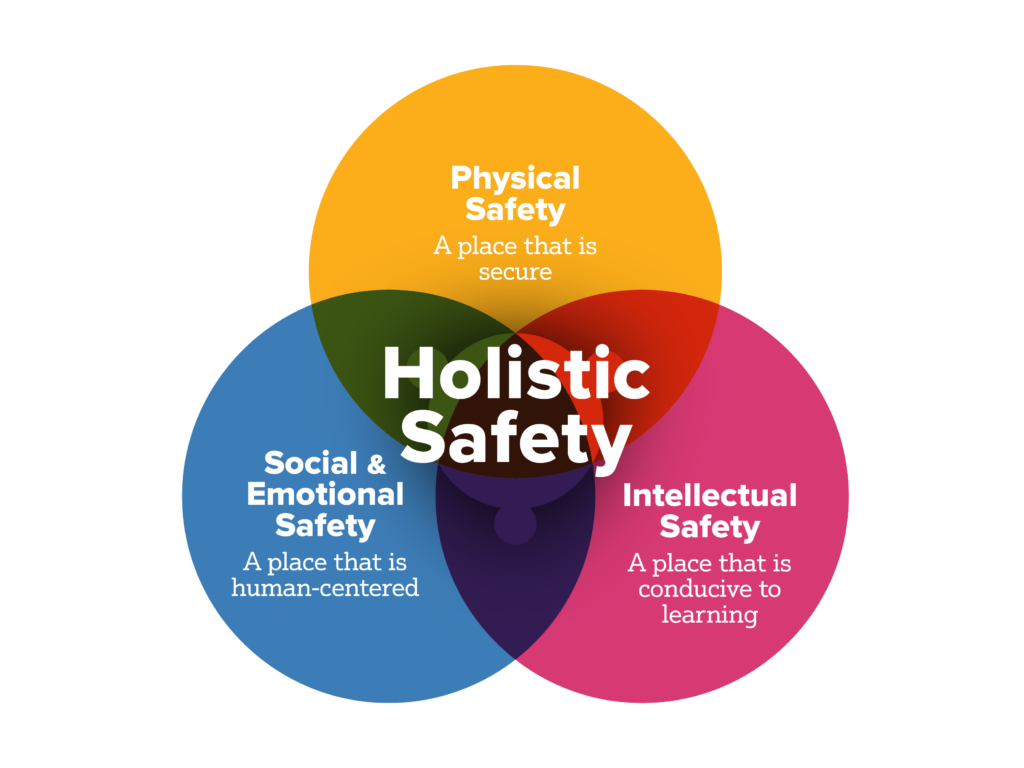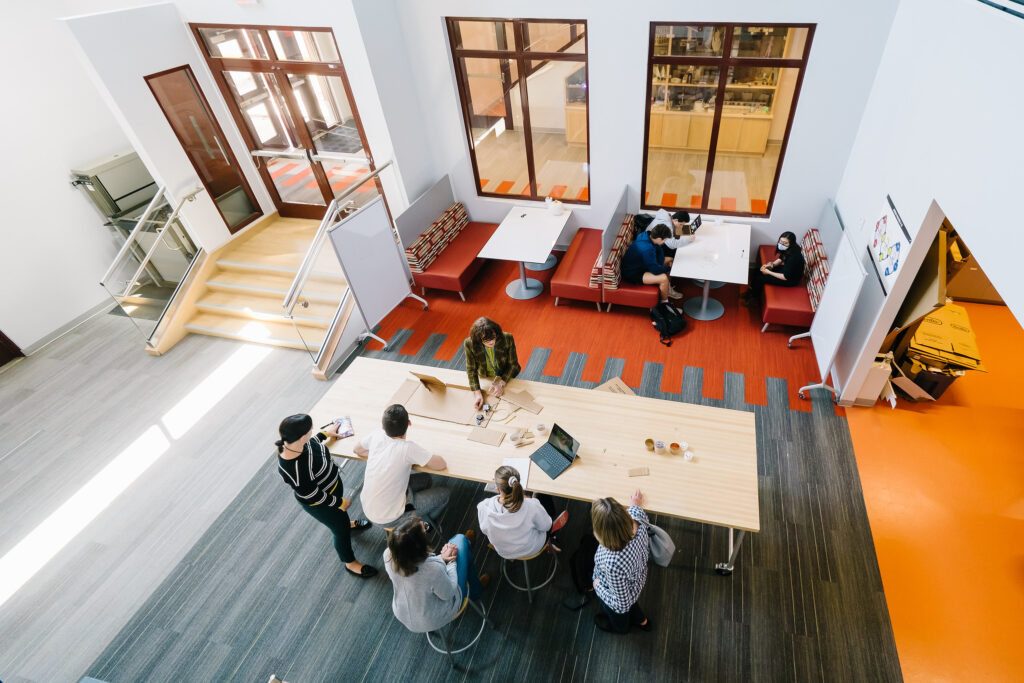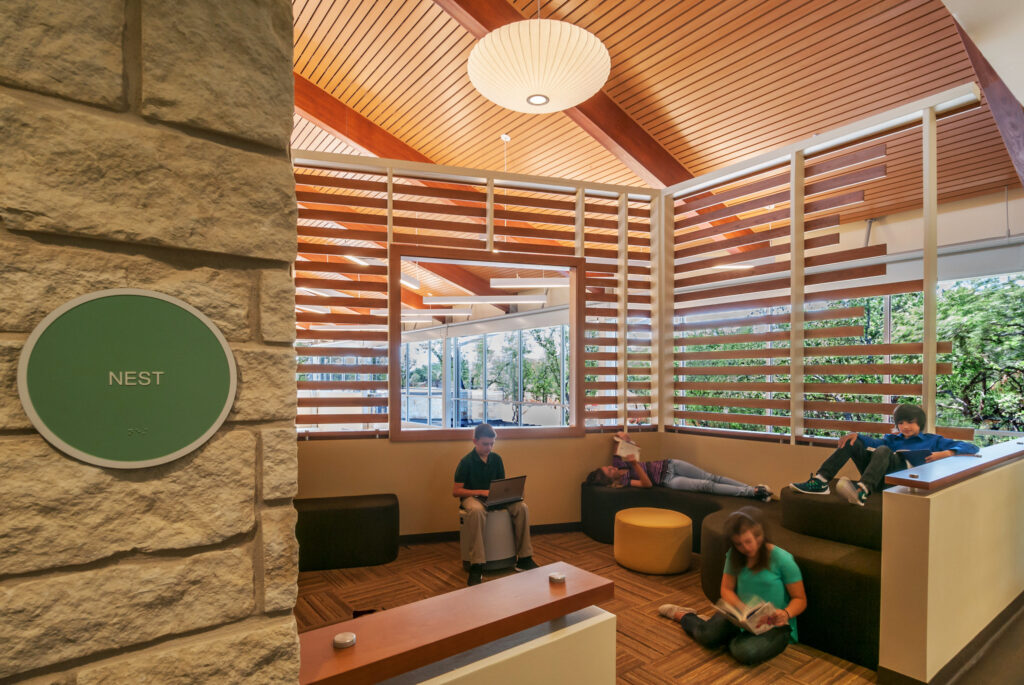Introduction: The Missing Piece of School Safety
Imagine walking into a school where students feel both protected and empowered. Common areas hum with conversation, flexible spaces foster learner-centered pedagogy, and quiet nooks offer refuge for reflection. There is a sense of ease — of belonging. Contrast this with a school designed like a fortress: metal detectors at the entrance, limited connections to nature, classrooms locked down like bank vaults. In which environment would students feel safer? More importantly, in which would they thrive?
For too long, the conversation around school safety has been dominated by reactionary security measures — hardened perimeters, armed guards, and active shooter drills. While these strategies may mitigate external threats, they do little to address the underlying issue: disconnection. Research consistently finds that students who feel isolated or alienated are at greater risk for distress, disengagement, and even violence. True safety requires more than locked doors; it requires an environment where students feel connected, valued, and able to learn without fear.

This is where Holistic School Safety comes in. At Fielding International, our experiences in designing schools around the world, along with research from fields including psychology, architecture, and education, suggest that the safest schools are not just physically secure but also socially and intellectually supportive. These schools integrate three essential safety domains:
- Physical Safety – Ensuring students feel protected through thoughtful design, natural surveillance, and clear emergency protocols.
- Social & Emotional Safety – Cultivating a sense of belonging through connection, inclusivity, and well-being-centered spaces.
- Intellectual Safety – Creating environments that encourage curiosity, risk-taking, and self-expression by providing choice and agency.
Maslow’s Hierarchy of Needs provides a compelling framework for understanding how these domains interact. A school cannot truly be safe if it only addresses students’ physiological and security needs while neglecting their fundamental need for belonging, esteem, and self-actualization. In this article, we explore how school design can forge a connection between Maslow’s principles and Holistic School Safety —creating learning environments where students feel secure enough to reach their full potential.
Laying the Foundation: Physical Safety as a Baseline
Before students can focus on learning, they must feel physically secure. Traditional safety measures — secure entrances, controlled access points, and emergency preparedness — remain essential. But physical safety should not come at the cost of a school’s warmth and openness. A fortress-like design, while well-intentioned, can erode the very sense of security it aims to create.
Instead, architects and designers can prioritize safety while maintaining an inviting environment through strategies such as:
- Natural Surveillance: Designing clear sightlines, eliminating blind spots, and using glass walls to promote passive supervision.
- Layered Access Control: Defining secure entry points while ensuring multiple exits for emergency egress.
- Territorial Reinforcement: Using landscaping, color, and architectural elements to create intuitive wayfinding and a welcoming yet secure boundary.

One concern we often hear is, “Glass walls will distract kids.” In our experience, this is not true. Disengaged kids get distracted — period. If we don’t create learning experiences that deeply engage students, they will be distracted no matter what type of wall their classroom has. Glass walls, when used thoughtfully, promote transparency, connection, and passive supervision, all of which enhance safety and engagement.
Physical safety provides a necessary foundation. But safety does not end with locked doors; it begins with relationships.
Sandy Hook Elementary School provides a powerful case study. In rebuilding after tragedy, the community resisted the urge to create a bunker-like structure. Instead, the school was designed with spatial variety, abundant natural light, and a layout that fosters both security and connection — proving that safety and warmth are not mutually exclusive.
The Linchpin of Safety: Social & Emotional Well-Being
Physical security measures may protect students from external threats, but they do not address the internal struggles that many students face. Maslow’s third level — belonging — is the linchpin of Holistic School Safety. Without it, neither physical nor intellectual safety can be fully realized.
School design has the power to counteract these forces by fostering social connection and emotional well-being.
Belonging is more critical than ever. As Jonathan Haidt explores in The Anxious Generation, today’s students are experiencing unprecedented levels of disconnection and loneliness. A combination of smartphone overuse, reduced independence, and fewer face-to-face interactions has left young people more isolated and less resilient. School design has the power to counteract these forces by fostering social connection and emotional well-being.
Schools that prioritize social-emotional safety create environments where students feel seen, heard, and valued. Design plays a crucial role in fostering this sense of connection:
- Commons and Gathering Spaces: Informal meeting areas encourage conversation and relationship-building.
- Decompression and Reflection Areas: Quiet rooms and sensory-friendly spaces offer refuge from overstimulation.
- Biophilic Design Elements: Access to natural light, views of nature, and organic textures reduce stress and promote well-being.
- Inclusive and Flexible Environments: Adaptive layouts accommodate neurodiverse students and different learning needs.

Bullying prevention is also deeply tied to design. Research shows that bullying thrives in isolated, unsupervised spaces. Schools can counteract this by ensuring transparency in walkways, incorporating home-like bathrooms, and creating shared areas that encourage positive social interactions.
The benefits of social-emotional safety extend beyond well-being. When students feel a sense of belonging, they are more engaged, more likely to take academic risks, and more resilient in the face of challenges.
The Peak of Safety: Intellectual Courage & Agency
Maslow’s fourth and fifth levels — esteem and self-actualization — represent the highest form of safety: the ability to take risks, ask questions, and engage deeply in learning. Intellectual safety is the confidence that students feel when they know their ideas, identities, and learning needs are respected.
Designing for intellectual safety means creating environments that encourage both collaboration and independence:
- Flexible Learning Environments: Movable furniture, varied seating arrangements in a variety of space types — including open and closed, specialized and multi-use — provide students with choice and autonomy.
- Identity-Affirming Design: Schools should reflect the cultural diversity of their students, incorporating student artwork, languages, and design elements that signal inclusion.
- Small-Group & Personalized Spaces: Learning happens everywhere — not just in classrooms. Spaces for small-group discussions, individual focus work, and one-on-one mentorship strengthen intellectual safety.
True safety is not just about preventing harm. It is about designing schools where students feel protected, inspired, and ready to reach their fullest potential.
A variety of spaces unlocks student agency, a critical factor in intellectual safety. When students have the ability to choose where and how they learn, they develop self-confidence, adaptability, and ownership over their education. Variety of spaces also unlocks authentic teacher collaboration, which helps schools develop stronger interdisciplinary learning and provides teachers with a critical layer of support when they aren’t working in isolation. Schools that embrace this model move beyond rigid, one-size-fits-all classrooms and instead create dynamic environments that support exploration, problem-solving, and discovery.
Conclusion: The Future of Safe, Thriving Schools
If we continue to define school safety solely through the lens of security, we will miss the deeper issue. Students cannot thrive in environments where they feel disconnected or unseen. By aligning school design with Maslow’s Hierarchy of Needs, we can create learning environments where students are not just physically safe but emotionally and intellectually secure.
Whenever we engage with school communities and they are talking about school safety, we must have the courage and knowledge to shape the conversation. Holistic School Safety is not just an ideal — it is what research, experience, and the needs of students demand.
True safety is not just about preventing harm. It is about designing schools where students feel protected, inspired, and ready to reach their fullest potential. The call to action for architects, designers, and school planners is clear: How can we build schools where every student feels safe enough to strive for self-actualization?

